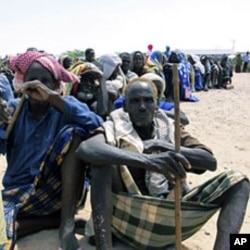The World Meteorological Organization (WMO) says the Horn Of Africa can look forward to weaker drought conditions in the coming months. In its latest El Nino/La Nina update, the WMO says near neutral or weak La Nina conditions, which lessen the severity of drought, are the most likely scenarios for the rest of 2011.
The El Nino and La Nina phenomena, which occur in the tropical Pacific, have a significant impact upon weather and climate around the globe. The World Meteorological Organization says there is a possibility that La Nina conditions, where sea surface temperatures cool, may re-emerge over the coming months. But, if this happens, it says the event is likely to be much weaker than the moderate to strong La Nina, which prevailed in 2010 and ended in May 2011.
That La Nina was linked to disastrously wet conditions in parts of Australia, Indonesia, Southeast Asia, and portions of northern South America. At the same time, it caused drought in East Africa.
WMO Climate Expert Rupa Kumar Kolli says if La Nina re-emerges it would result in rainfall, which is either normal or below normal. This, he tells VOA, could potentially spell bad news for East Africa but he adds that drought conditions are still likely to be less severe than in the past two years.
“There is reason to be concerned about the situation. But, at the same time, even if La Nina occurs, the current indications are that it is likely to be weak and is not going to be anywhere close to the moderate to strong La Nina that we have seen last year," said Kolli. "In that sense, even if it is slightly below normal, it is really not alarming and it is very unlikely that we will see a very severe drought condition to happen in Eastern Africa.”
More than 12 million people in Kenya, Ethiopia, Djibouti and Somalia are struggling to cope with the worst drought to hit the Horn of Africa in 60 years. People in Somalia are particularly hard hit as they try to survive the twin disasters of conflict and drought. The United Nations has declared several regions in southern Somalia to be famine zones.
Kolli says the drought in the Horn of Africa came as no surprise to meteorologists. He says the impact resulting from the La Nina event was expected and he says regional weather centers warned countries of the severity of the drought that was looming.
Once countries have been warned of a possible weather-related disaster, he tells VOA it is up to their governments to take appropriate measures to try to lessen the expected impact.
“Famines are man-made, whereas droughts are natural parts of the system. So, the drought warnings were given sufficiently in advance to the policy makers,".Kolli added. "But, the famine conditions are a combination of the drought and other factors, which actually create a situation where people have no access to food.”
WMO Climate Expert Kolli says meteorologists are trying to improve ways of getting policy makers to take their warnings more seriously. He says they are trying to see how they can better communicate weather and climate information. He says it is important to make policy makers understand they must take appropriate decisions based on the regional forecasts they receive.















